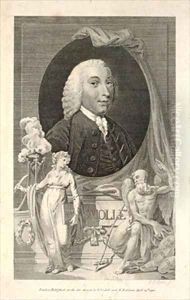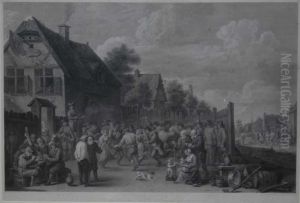Joseph Collyer Paintings
Joseph Collyer, also known as Joseph Collyer the Younger, was an eminent English engraver and occasional painter, born in 1748. He was the son of Joseph Collyer the Elder, who was also an engraver. Collyer's artistic education began under his father's guidance, and he further honed his skills by apprenticing with the well-known engraver Anthony Walker. His talent was recognized early on when he won a Society of Arts premium in 1761.
Collyer's career flourished in the late 18th century, a period known for the rise in popularity of printmaking and book illustration in England. He became a sought-after engraver for his refined style, which was characterized by its clarity and delicate rendering. He worked on a variety of subjects, including portraits, decorative pieces, and historical scenes. Notably, Collyer was responsible for creating the engravings for a number of important publications of the time, such as the illustrations for Oliver Goldsmith's 'The Vicar of Wakefield' and for editions of works by authors like William Shakespeare and John Milton.
Aside from book illustrations, Collyer also produced engravings for the Royal Academy of Arts exhibitions. His works received critical acclaim, and he was appointed as an Associate Engraver of the Royal Academy in 1775, a significant honor that underscored his contributions to the art form.
Collyer's legacy extends beyond his engravings. He was also known for his mentorship and influence on younger artists. He often collaborated with painters, translating their works into engravings that could be enjoyed by a wider audience through prints. Collyer's dedication to his art continued throughout his life, and his engravings remain a testament to his skill and the importance of printmaking in the dissemination of art during his time.
Joseph Collyer passed away in 1827, leaving behind a body of work that continues to be appreciated by art historians and collectors. His engravings capture the aesthetic sensibilities of the late 18th century and provide insight into the period's artistic and cultural milieu.

